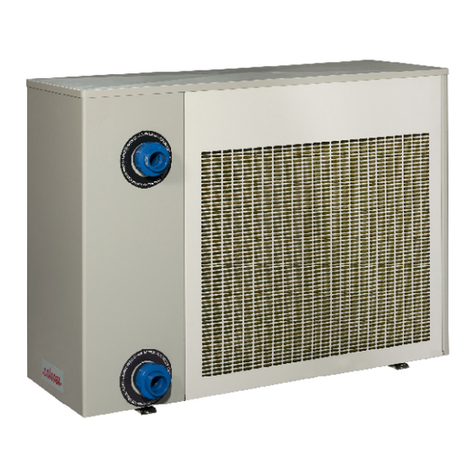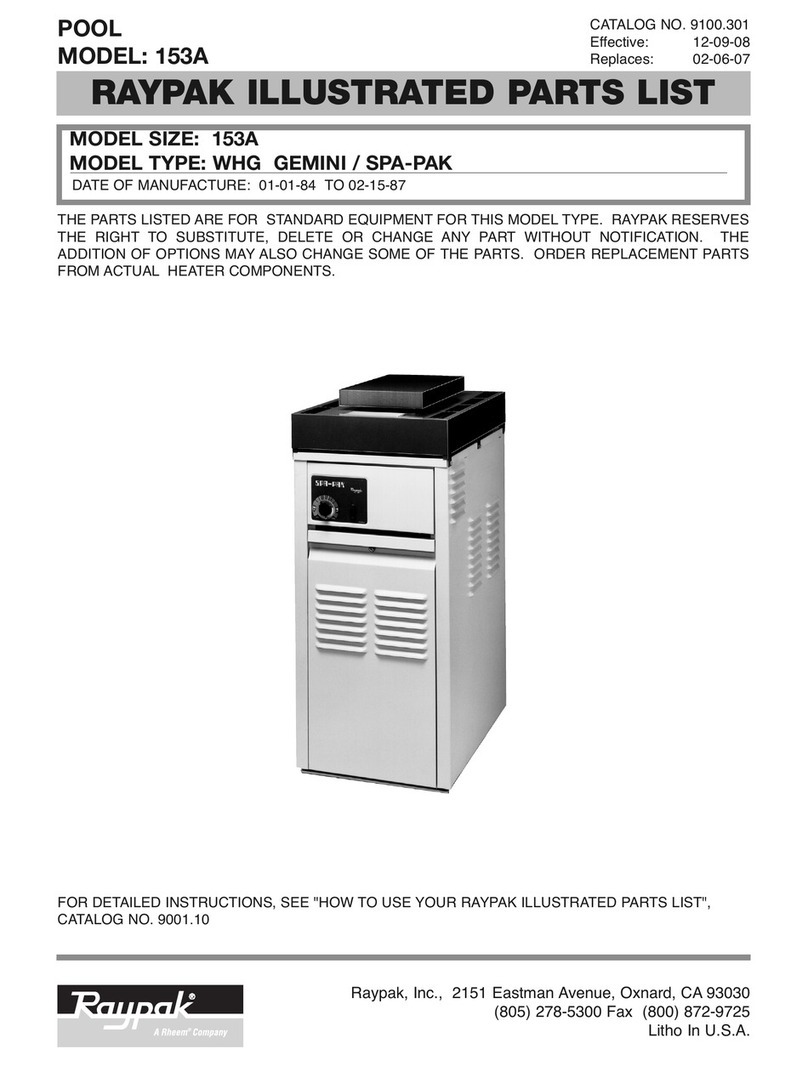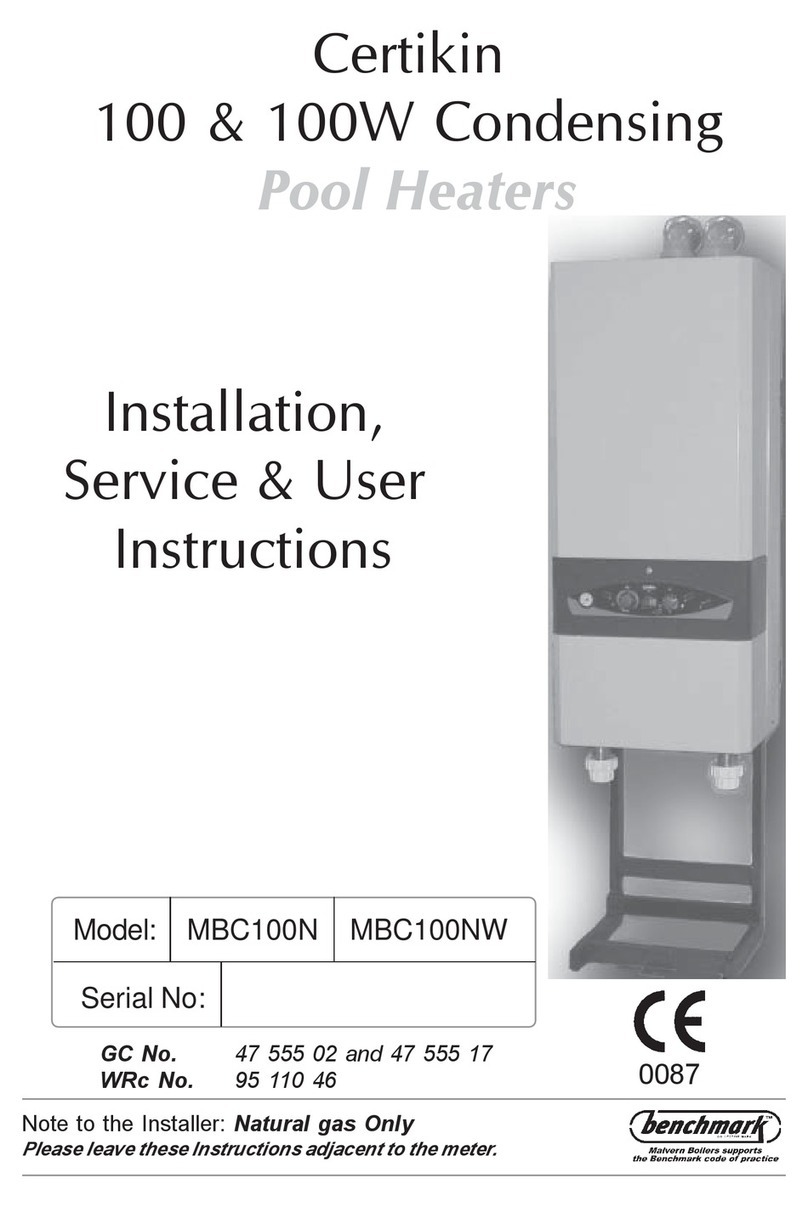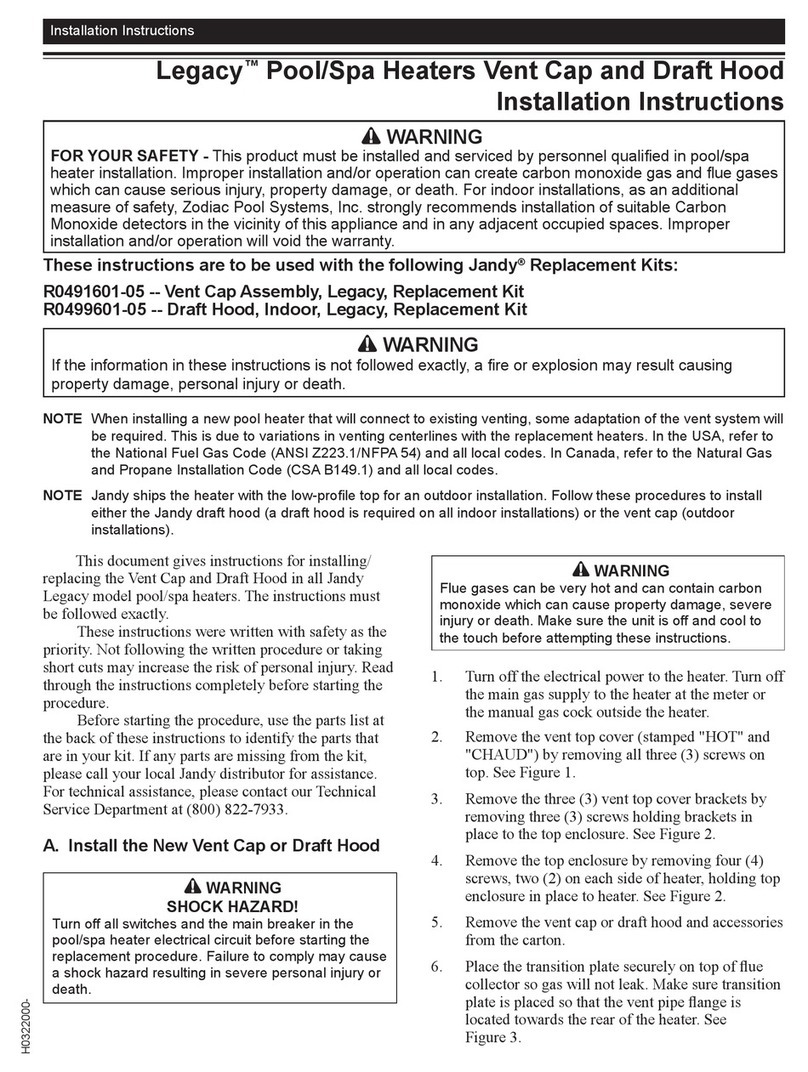Vulcan-Hart Pool Heater Installation instructions

VULCAN Pool Heater
Installation & Operating Manual

1
ENGLISH
Important Notes!
Thank you for purchasing the VULCAN direct electric swimming pool
heater manufactured in England to the highest standards.
To ensure your new heater will give years of trouble free service please
carefully read the following instructions. Incorrect installation will
aect your warranty.
Do not discard this manual, please retain for future reference.
Product Overview
Fig 1.
DIGITAL
Version
ANALOGUE
Version

2
Positioning
Your heater must be horizontally or vertically sited allowing sucient
space for pipe connections and wiring, it should be screw xed securely to
a rm base or wall.
NOTE: See gure 2 for details of the foot arrangement when securing
to the wall or oor.
The heater should be installed at a low point in the ltration system.
It should be positioned downstream (after) of the lter and upstream
(before) of any dosing or other water treatment plant. (see g.3)
NOTE : If the ow direction is reversed (explained later in this
booklet) the heater must remain sited after the lter.
Factory set oor
mount ‘Foot position’
To reset for wall
mount option,
undo the bolts and
re-assemble in the
vertical position as
shown.
Floor mount ‘Foot position’
Wall mount ‘Foot position’
Fig 2.
ENGLISH

3
ENGLISH
Flow switch
at top
For vertical wall
mounting water
must always enter
at the bottom
Fig 3.
Fig 4.
PUMP FILTER
POOL
VULCAN HEATER
NON RETURN
VALVE
WATER
TREATMENT

4
Pipe Work
It is essential that the pipe work connecting to and from the heater
has a minimum bore (internal diameter) of 1¼” (32mm). To assist correct air
purging and to ensure the heater remains completely full of water during
operation, the return pipe which carries the water back to the pool must
incorporate a safety loop or ‘kick-up’ in the pipe as close as possible to the
heater (see g 4)
NOTE: When coupling to a exible pipe a safety loop can simply be
created by routing the pipe up and over an obstacle.
Remember to use pipe clips to securely fasten all hose connections.
Weather Protection
The heater must be installed within a dry weather proof enclosure.
Caution! If the heater is not used during winter months it must be drained to
prevent frost damage.
Electrical Connection
The heater must be installed in accordance with the country / regional
requirements & regulations. In any event the work must be carried out by
a qualied electrician, who will provide a certicate of conformity upon
completion of the work. The power supply must be tted with a RCD. If
required your electrician may replace the supplied cable entry gland with a
larger size to secure the cable powering the heater, this will not aect your
warranty if carried out by a qualied electrician.
Cable section: This should be calculated at 5-amp / mm for distances
up to 20 metres (these sections are indicative and should be checked and
adapted if necessary for cable lengths over 20 metres.
ENGLISH
Remove Access Cover
to make the electrical
connections
(Qualied electricians only)
Fig 5.

5
ENGLISH
Power Requirements
Flow Requirements
Your heater is factory set to accept input water ow entering on the left
and exiting on the right, this can be reversed by rotating the ow switch
180 degrees (ie:½ turn, see g 6)
Warning! The ow switch paddle can be damaged when reversing the ow
direction if it is lifted by more than 5mm from its housing and turned with
force. If the ow switch has been rotated it is important to ensure that it is
nally locked in the correct orientation perpendicular (at right angles) to the
ow of water.
Power
Output
Voltage
(V) Amp
3 - kW 230 13
4.5 - kW 230 20
6 - kW 230 27
9 - kW 230 40
12 - kW 230 53
15 - kW 230 66
3 Phase
Power
Output
400 V Star /
230 V Delta Amp
6 - kW 400 / 230V 9 / 15
9 - kW 400 / 230V 13 / 23
12 - kW 400 / 230V 18 / 31
15 - kW 400 / 230V 22 / 38
To reverse ow:
Loosen cap and rotate
Flow switch by 180 degrees
as shown. Always ensure
the arrow marked on the
plastic ow switch body is
in the same direction as the
water ow.
Factory set ow
Optional reverse
o w
Flow
Fig 6.

6
The ow rate of water into the heater must not exceed 17,000 litres per
hour (3,740 UK gallons/hour) A higher ow rate will require the installation
of a bypass to prevent damage to the heater elements. The heater will not
operate unless the following minimum ow rates are achieved ie:
1,000 litres / hour (220 UK gallons/hour) for 3 ~ 6-kW heaters and
4,000 litres / hour (880 UK gallons/hour) for 9 ~ 15-kW heaters.
Water Quality
The water quality must be within the following limits:
PH 6.8 - 8.0
TA (Total alkalinity) 80—140ppm (parts per million)
Chloride Content MAX: 150 mg/litre
Free Chlorine: 2.0 mg/litre
Total Bromine: Max 4.5 mg/litre
TDS (Total Dissolved Solids) / Calcium hardness 200— 1,000ppm
Water chemistry is complicated if in doubt seek expert advise.
Operating Your Heater
Upon completion of the installation, run the water-circulating pump to
purge the system & heater of air (i.e. Remove any trapped air in the
system & heater). TIP: You can encourage air out of the heater ow tube by
gently elevating the exit port of the heater when the pump is running.
On initial power up of the heater the amber light should illuminate.
The heater will only switch ‘On’ (red light indicator illuminated) and the
amber light switching ‘O’ when the following criteria are met ie:
Water circulating pump is ‘On’ delivering in excess of the minimum ow•
rate of water (see ow requirement information)
Water temperature set point (required temperature) is set to a higher•
value than that of the water.
ENGLISH

7
Analogue set-up
Rotate the Temperature ’Set point’ dial located on the front of the unit
(see g 1) to the required water temperature.
Digital set-up: Thermostat controller / Temperature display
The digital thermostat displays the temperature in ºc
The digital thermostat tted to your pool heater has been pre-
programmed with all the necessary parameters to ensure reliable service
and operation.
All you need to do is set the temperature you would like your water to be
maintained at, this is known as the required set point temperature.
To display / modify the required temperature, press and release the P
button.
The pre-programmed required temperature will be displayed.
Press (3)to increase or (2) to decrease the required temperature.
When the correct required temperature is displayed, press and release
the P button. The unit will then revert to displaying the current water
temperature, but will now control the water temperature, to a maximum of
the required temperature.
ENGLISH
Item Description Function
1 ‘P’ button
To display / modify
the required
temperature
2 ‘Down’ button To decrease the
value
3 ‘Up’ button To increase the
value
4 ‘U’ button NOT USED
5LED–out
Indicates that the
water temperature
has fallen below
the required
temperature
Fig 7.

8
ENGLISH
Time switching delay
To prevent overheating of the components within the heater caused by
frequent ’On’ and ’O’ switching (cycling) the digital thermostat has been
pre-programmed with a time delay function. This prevents rapid uctua-
tions in water temperature from switching the heater ’On’ and ’O’ more
than once in a two minute period. The time delay mode is indicated by the
ashing of the Red indicator (5) on the digital thermostat (see g.7)
Dierential: When the water has reached the required temperature
the heater will switch ’O’ and will not switch back ’On’ until the water
temperature has dropped by 0.6º C. This value is known as the dierential
and is also in place to prevent overheating to the switch components
caused by cycling.
High temperature alarm
Your heater has a high temperature fail-safe relay linked to a visual high
tem-perature alarm display. This alarm is shown as ‘HI’ ashing within
the temperature display window. This alarm is activated if the water
temperature is 2º C (or more) above the required temperature. As soon as
the water temperature falls back to the required temperature the alarm
will stop ashing and the heater will automatically reset and operate as
normal.
Please note: If you decrease the required temperature by 2º C (or
more) below the current water temperature this will also result in the
high temperature alarm being displayed.
Function Testing
Q: How long will it take to heat my pool?
A: Assuming no heat losses, and a heater sized in the ratio 1.5-kW per
1,000 UK gallons of water (4,545-litres): it will take 2 days of continuous
running to raise the temperature of a pool from tap temperature
to swimming temperature. Heat loss will slow the heating process,
particularly during periods of cold weather, hence the higher
the water temperature is to be maintained above average ambient air
temperature, the slower the heating process will become.

9
ENGLISH
The only inuencing factors are the level of insulation and the location of
the pool with regard to wind shelter.
Useful advice: To reduce running costs and speed up the heating process;
Insulate the pool wherever possible. A oating solar cover is an essential
minimum to retain heat.
Quick Function Test
Observe the main electricity meter when the heater is on (ie: red light
‘On’) and then observe it again when the heater is in the standby mode
(ie: amber light ‘On’) The test should show that the meter is recording
more electricity being used by the heater when the red light is ‘On’. It is
impossible for an electric heater to waste energy, if it is drawing power
then that power will be turned into heat that will be trans-ferred to the
water.
Accurate Function Test
If a more accurate test is required to conrm that your heater is delivering
the specied heat output, two electricity meter readings will need to be
taken from the properties main electricity meter, with an exact one hour
interval (ie: take one meter reading and then a second reading exactly one
hour later) then by subtracting the rst reading from the second reading
the number of units (kilo watts kW) consumed can be calculated. Note that
your heater is also rated in kW hours.
The pool pump and heater will need to be running continuously during
the test (ie: with the heater red light ’On’) To avoid inaccurate results when
performing this test, it is important to refrain from using other high current
consuming appliances in the property (such as tumble dryer, showers,
cookers etc).
A large domestic pool pump of 1 horsepower will draw less than 1kW in a
one hour period. The conclusion of the test should prove that for example
a 6kW heater and a ½ horsepower pump will draw between
6.3-kW ~ 6.5-kW in one hour. It is impossible for an electric heater to waste
energy, if it is drawing power then that power will be turned into heat that
will be transferred to the water.

10
ENGLISH
Trouble Shooting – Analogue
HEATER WILL NOT SWITCH FROM STANDBY (AMBER LIGHT ) TO ON
(RED LIGHT)
In most cases this will be the result of one of the following points not
being met.
Possible cause 1: The set point temperature has been achieved.
To conrm increase the set point value by turning the temperature set
point dial to a value greater than the current water temperature.
Possible cause 2: The high limiting thermostat has tripped.
Remedy: Remove button cover and press red button to re-set (see g 8)
If a positive click is felt, the cause of the tripping must be investigated and
could be caused by a debris build-up or air pocket trapped inside the ow
tube of the heater.
Possible cause 3: Insucient ow.
If using a cartridge lter: Conrm this by running the system with the
cartridge removed from your pump & lter unit, this will supply the heater
with the maximum ow rate your unit is capable of. If the heater then
switches ’On’ (ie: red light ’On’) a blocked cartridge can be conrmed to be
the cause. The cartridge should be cleaned or replaced.
If using a sand lter: Check the pressure indicator on your sand lter and
back wash if necessary.
Fig 8.

11
ENGLISH
Note: In some cases the high limit thermostat tripping and a low ow
rate can be linked ie: when a lter becomes choked air can be drawn
into the ltration system and become trapped inside the heater so
causing the thermostat to trip.
Trouble Shooting – Digital
HEATER WILL NOT SWITCH FROM STANDBY (AMBER LIGHT ) TO ON
(RED LIGHT)
In most cases this will be the result of one of the following points not
being met.
Possible cause 1: The set point temperature has been achieved.
To conrm that the digital thermostat is requesting the unit to heat, see if
there is an illuminated dot above the word ’Out’ on the digital thermostat
display (see g 9) If illuminated go to step 2, if not illuminated raise the
required temperature to a value higher than the current water tempera-
ture. Conrm whether the heater now switches to ’Heat on’ mode (red
light)
Possible cause 2: The high limiting thermostat has tripped.
Remedy: Remove button cover and press red button to re-set (see g 8)
If a positive click is felt, the cause of the tripping must be investigated and
could be caused by a debris build-up or air pocket trapped inside the ow
tube of the heater.
Possible cause 3: Insucient ow.
Remedy: If the display is ashing ‘noFL’ the ow rate has dropped below
the minimum level or has stopped completely. The cause of the reduced /
static ow rate should be investigated and resolved.
Fig 9.
If continuously illuminated:
Indicates that the current
water temperature has
fallen below the required
temperature.
If ashing:
Indicates that the unit is in
‘Time delay’ mode.

12
General Trouble Shooting
NO LIGHT APPEARS ON THE HEATER WHEN IT IS SWITCHED ’ON’
Possible cause: Power failure external to the heater
Remedy: Check any fuses, RCD or other switch components installed in
the supply cable. Note: the heater is not tted with a fuse.
THE FLOW TUBE DOES NOT FEEL WARM
Due to the high eciency of your electric heater no warmth should be
detectable from the ow tube of the heater.
The most likely causes of the ow tube feeling warm are:-
Possible cause 1: The heater has been positioned in direct sunlight.
Possible cause 2: An air pocket is trapped inside the heater particularly if
the tank feels warmer at the highest point of the tank (as air rises).
THE WATER ENTERING MY POOL DOES NOT FEEL MUCH WARMER
The temperature gain of the water after it has passed through the heater
will be directly proportional to the volume of water being pumped in
relationship to the power output of the heater.
For example: A 6-kW heater, when connected to a 4,000 litre / hour
pump, will produce a lift in temperature of approximately 1.2 C (almost
undetectable to the human hand) however, as the water being heated is
re-circulated from a single body of water, the time required to heat it
remains unaected by the volume of ow. A popular misconception is that
slowing down the ow rate will speed up the heating process.
ENGLISH

13
ENGLISH
RoHS Compliance Statement
Elecro Engineering Limited certify that our Electric Swimming Pool Heater
Range complies in accordance with RoHS Directive 2002/95/EC on the
restriction of hazardous substances.
Waste Of Electrical / Electronic Equipment
This product complies with EU directive 2002/96/EC
Do Not dispose of this product as unsorted municipal waste.
This symbol on the product or on it’s packaging indicates that this product
should not be treated as household waste. Instead it should be handed
over to the applicable collection point for the recycling of electrical and
electronic equipment.
By ensuring this product is disposed of correctly you will
help prevent potential negative consequences for the
environment and human health, which could otherwise be
caused by inappropriate waste handling of this product.
The recycling of materials will help to conserve natural
resources.
For more information please contact your local Civic oce,
your household waste disposal service or the retailer
where you purchased the product.
Product Overview

14
Guarantee
Your heater is guaranteed from the date of purchase against faulty
workmanship and materials ie: 2 years guarantee for incoloy heating
element products and 3 years guarantee for titanium heating element
products.
The manufacturer will replace or repair, at it’s discretion, any faulty units or
components returned to the company for inspection.
Proof of purchase may be required.
The manufacturer will not be liable in cases of incorrect installation of the
heater, inapropriate use or neglect of the heater.
CE Declaration Of Conformity
The manufacturer declares that the herewith products or ranges
ELECTRIC SWIMMING POOL HEATER RANGE
Are in conformity with the provisions:
of the ELECTROMAGNETIC COMPATIBILITY directive 89/336/EEC, as
amended 93/068/EEC. Controlled by AEMC Measures laboratory—
technical report no P96045T
The harmonised standards have been applied: EN 55014—EN 55104
EN 55011
EN 55022
CEI 801-4
CEI 801-2
CEI 801-3
of the LOW VOLTAGE directive 73/23/EEC.
The harmonised standards have been applied
EN 60335-2-35
Product Overview
ENGLISH

90

91

11 Gunnels Wood Park |Stevenage |Hertfordshire |SG1 2BH |United Kingdom
t: +44 (0) 1438 749 474 |f: +44 (0) 1438 361 329 |e: info@elecro.co.uk
© Copyright 2011 Z-INS-VULC-EVO
Table of contents
Popular Swimming Pool Heater manuals by other brands
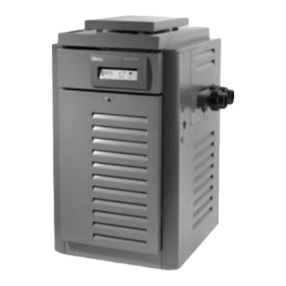
Raypak
Raypak P-R185A to P-R405A, C-R185A to Installation and operating instructions
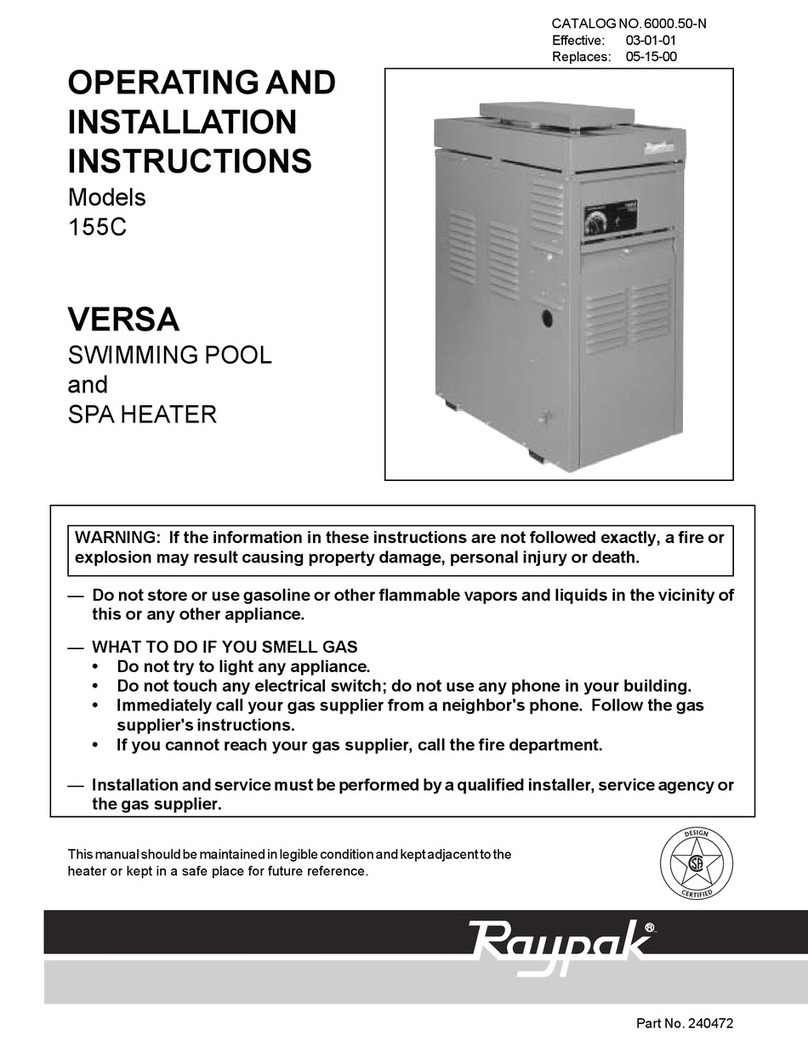
Raypak
Raypak VERSA 155C Operating and installation instructions
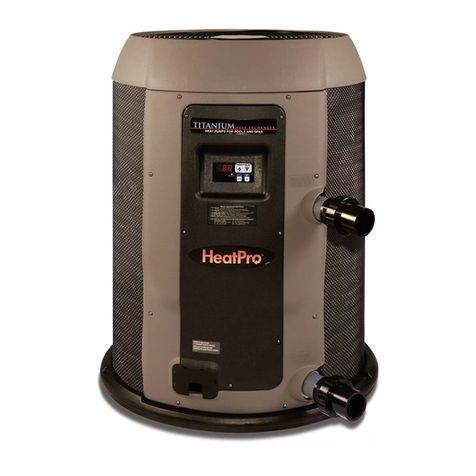
Hayward
Hayward HeatPro parts manual
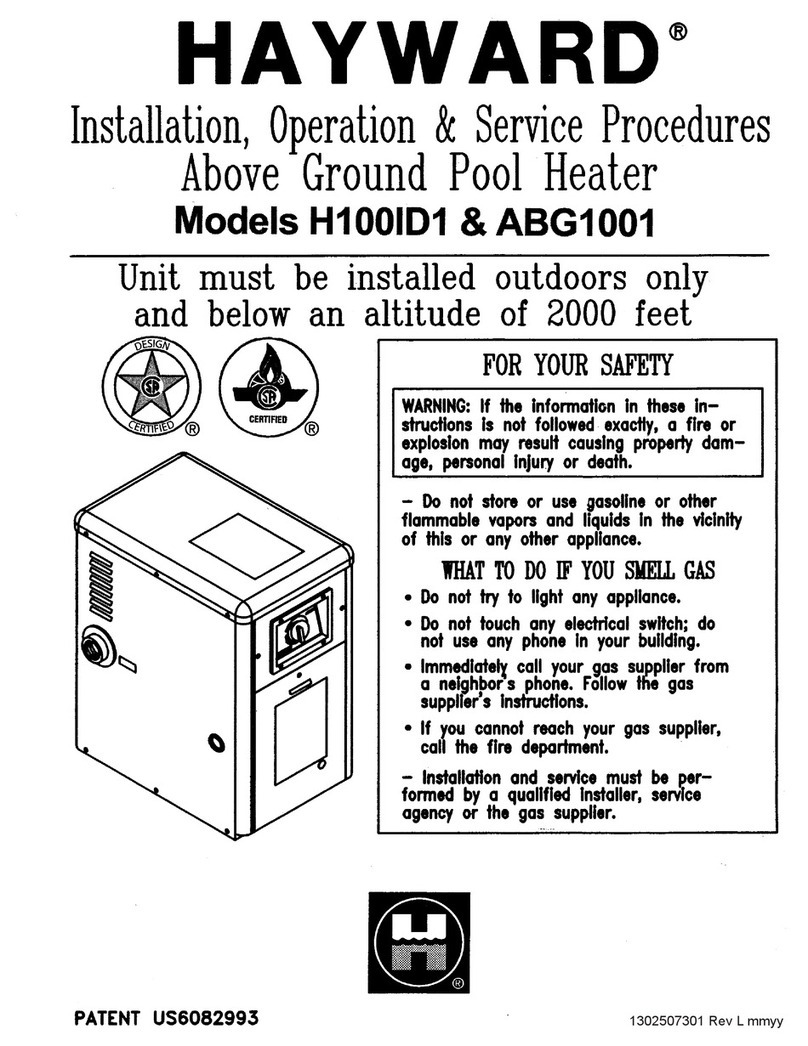
Hayward
Hayward H100ID1 Installation & operation manual
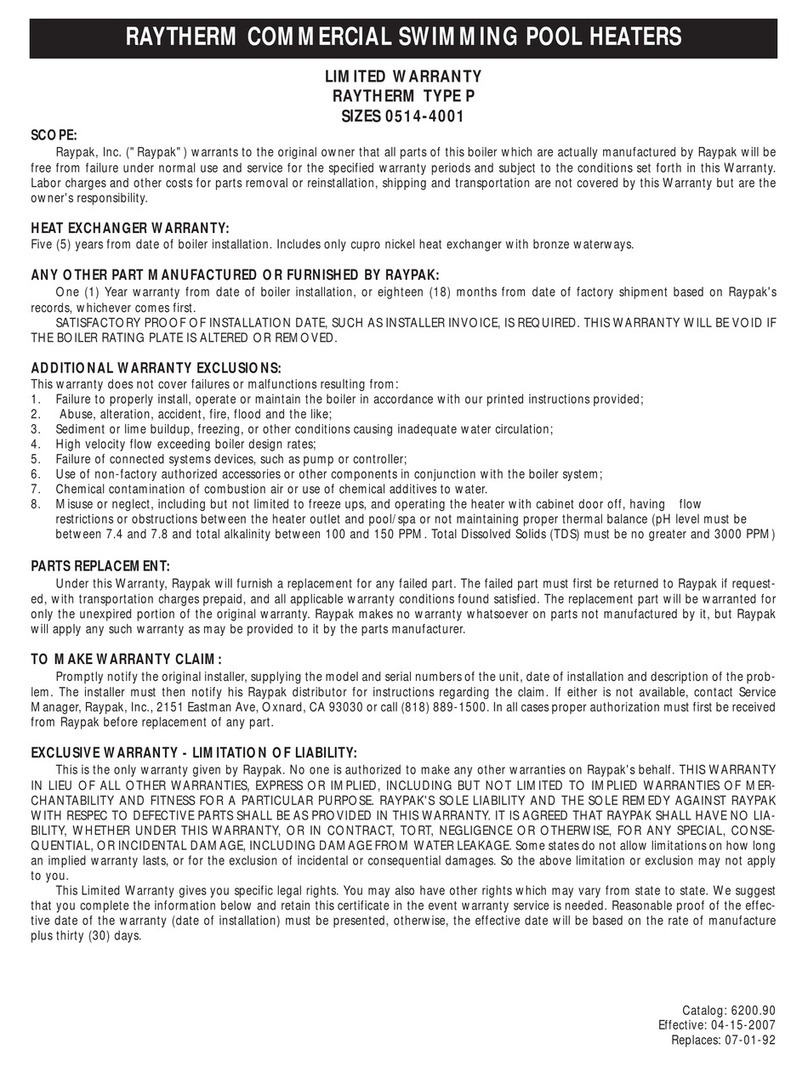
Raypak
Raypak 6200.90 Limited warranty
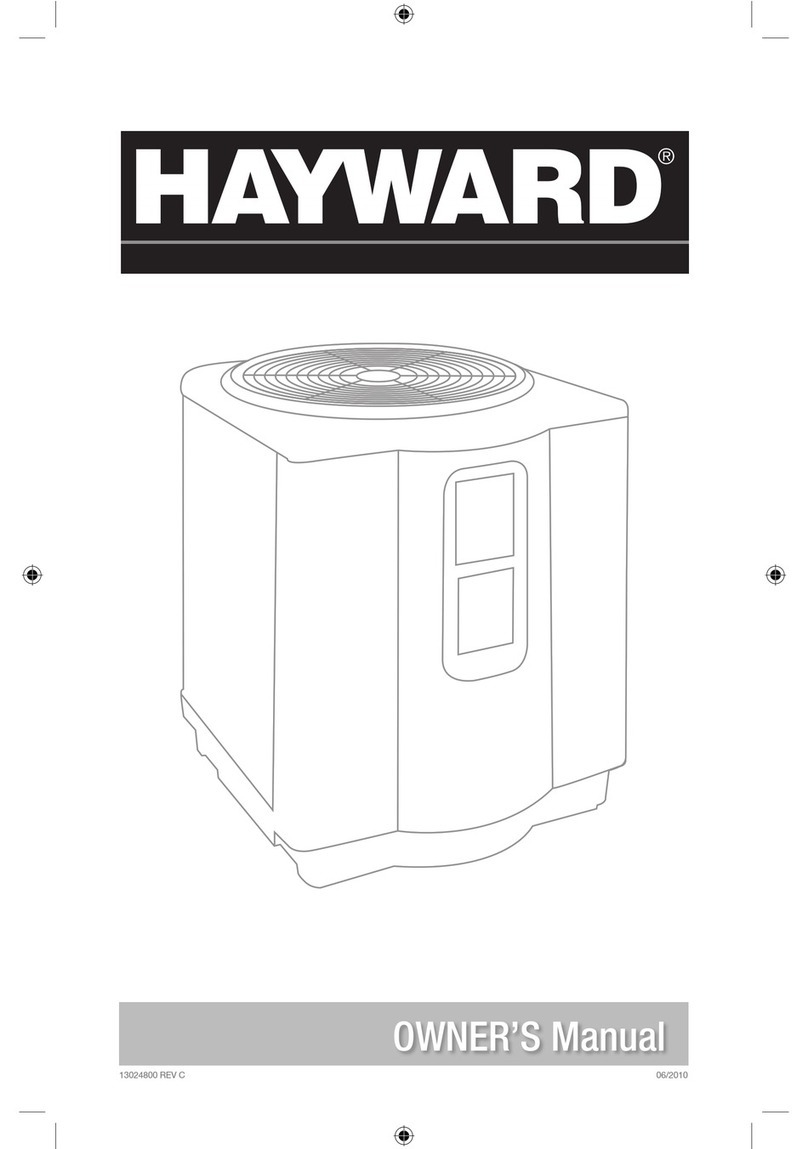
Hayward
Hayward Spa Heaters owner's manual
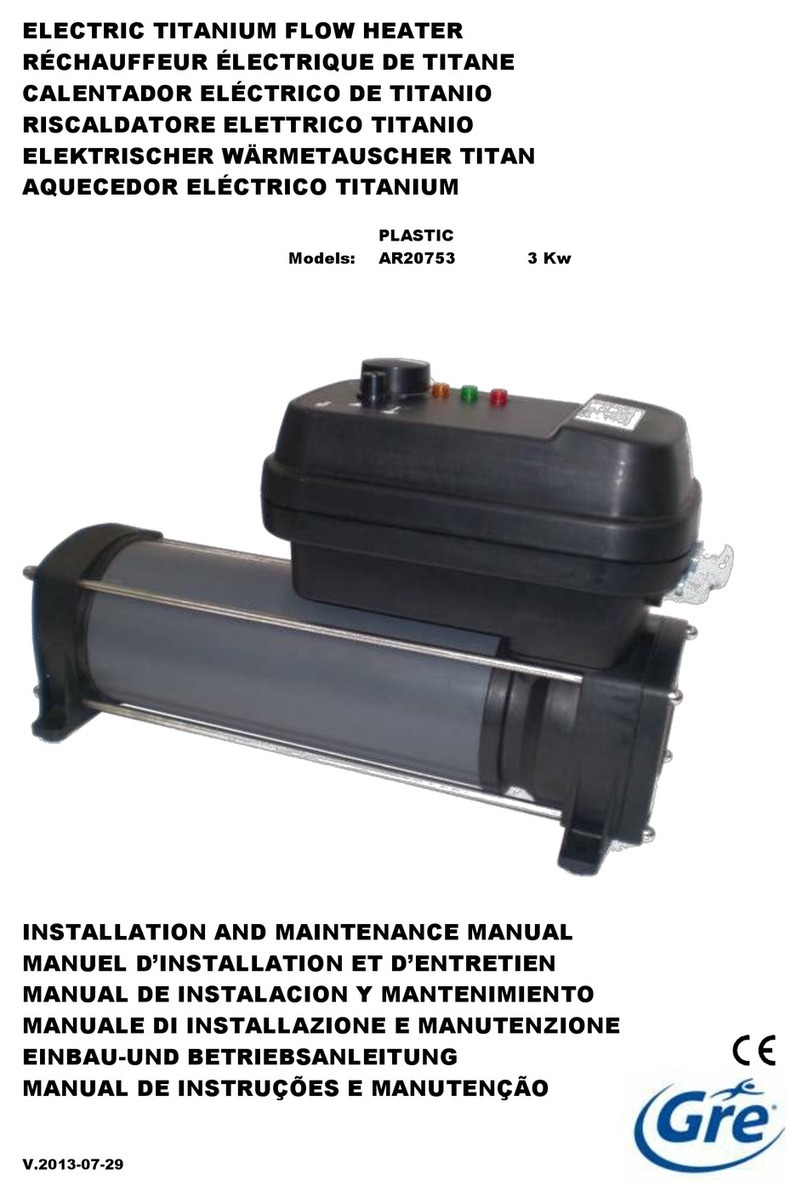
GRE
GRE AR20753 Installation and maintenance manual
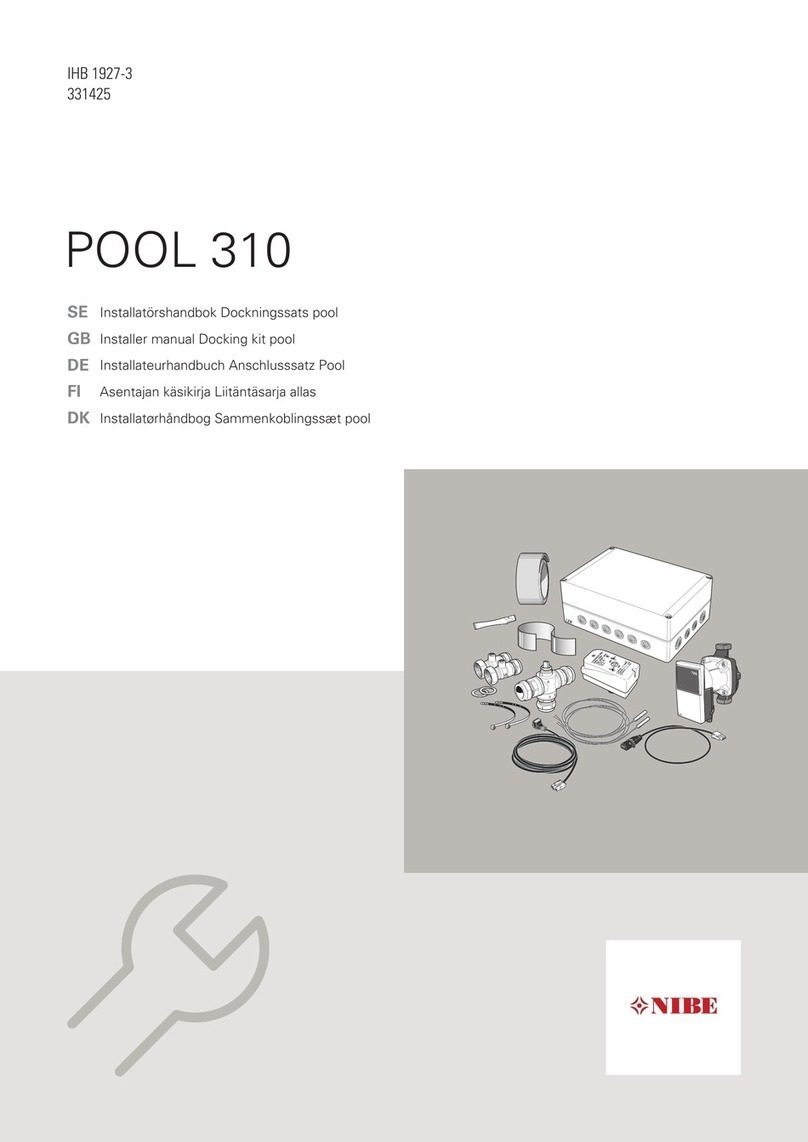
Nibe
Nibe POOL 310 Installer manual

Hayward
Hayward HP55TR Installation instructions manual

Hayward Pool Products
Hayward Pool Products HeatPro HP20654T installation guide

COSMOGAS
COSMOGAS POOLDENS 34T Installation, use and maintenance manual
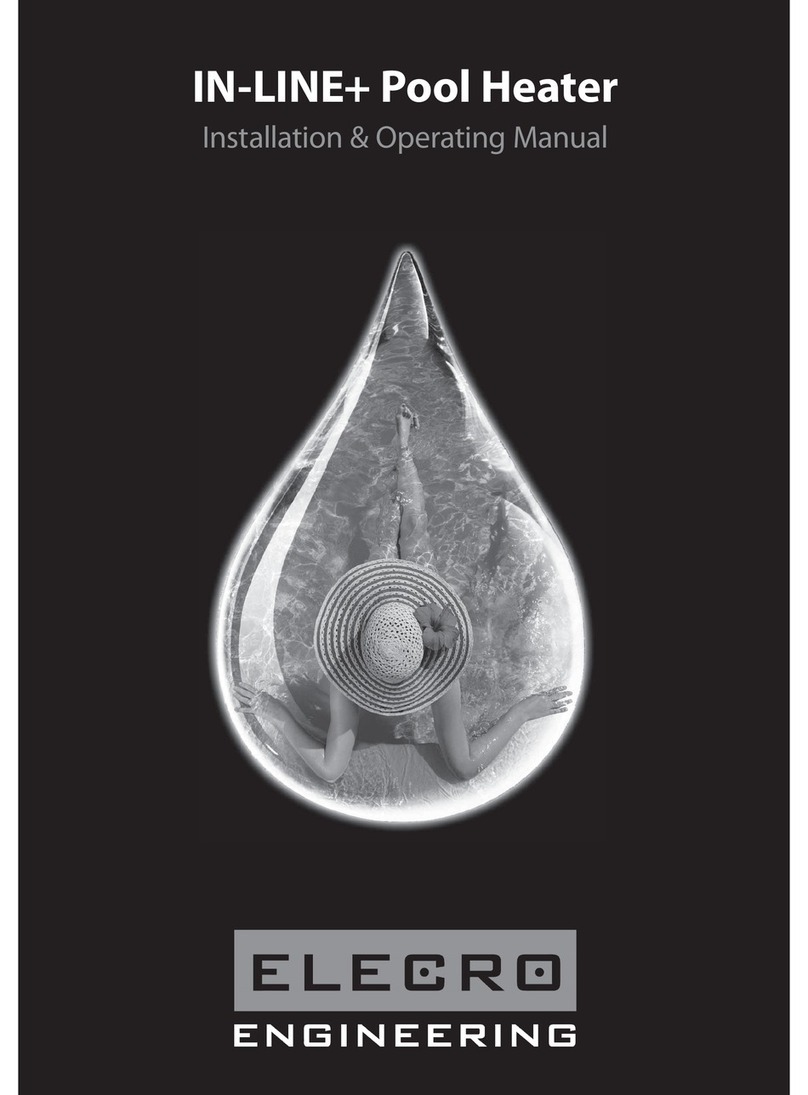
Elecro Engineering
Elecro Engineering IN-LINE+ Installation & operating manual
